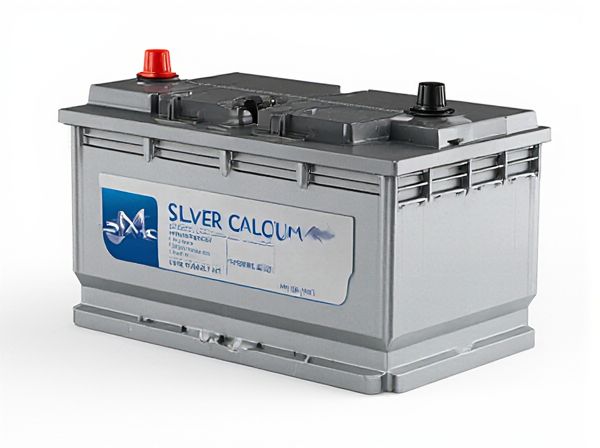
Photo illustration: Silver Calcium vs Standard Lead
Silver calcium batteries offer enhanced corrosion resistance and longer lifespan compared to standard lead-acid batteries, making them ideal for high-performance applications. Their improved charge acceptance and reduced self-discharge rate ensure reliable starting power and consistent energy output. You benefit from increased durability and maintenance-free operation when choosing silver calcium technology over traditional lead-based batteries.
Table of Comparison
| Feature | Silver Calcium Battery | Standard Lead Battery |
|---|---|---|
| Material Composition | Lead Alloy with Silver and Calcium | Pure Lead or Lead-Antimony Alloy |
| Corrosion Resistance | High - Enhanced lifespan | Lower - More prone to corrosion |
| Water Loss | Minimal - Reduced maintenance | Higher - Frequent water top-ups needed |
| Charge Acceptance | Faster Charging | Slower Charging |
| Self-Discharge Rate | Low | Higher |
| Service Life | 3-5 years | 1-3 years |
| Cost | Higher Initial Cost | Lower Initial Cost |
| Performance in Cold Weather | Better Cold Cranking Amps (CCA) | Lower CCA |
Introduction to Silver Calcium and Standard Lead Batteries
Silver calcium batteries enhance standard lead-acid technology by incorporating silver and calcium alloys into the lead plates, resulting in improved corrosion resistance and extended battery lifespan. These batteries offer higher charge retention, reduced self-discharge rates, and better performance under deep discharge conditions compared to traditional lead-acid batteries. Standard lead-acid batteries remain widely used due to their low cost and reliable starting power but typically require more frequent maintenance and have shorter cycle life than silver calcium variants.
Key Differences in Battery Composition
Silver calcium batteries contain a blend of silver and calcium alloys in the lead plates, enhancing corrosion resistance and conductivity compared to standard lead-acid batteries that primarily use pure lead plates. The incorporation of silver improves charge acceptance and extends battery lifespan under high-temperature conditions, whereas standard lead batteries typically exhibit slower recharge rates and reduced durability. Silver calcium batteries also maintain better performance with reduced water loss, making them ideal for applications requiring reliable, long-term power.
Performance Comparison: Silver Calcium vs Standard Lead
Silver calcium batteries offer superior performance compared to standard lead-acid batteries, delivering higher corrosion resistance and longer lifespan due to enhanced plate stability. These batteries maintain better charge retention and provide improved cold cranking amps (CCA), especially under extreme temperature conditions. The advanced alloy composition in silver calcium batteries results in reduced water loss and increased overall efficiency, making them ideal for demanding automotive and industrial applications.
Durability and Longevity
Silver Calcium batteries offer enhanced durability and significantly longer lifespan compared to standard lead-acid batteries, thanks to their improved corrosion resistance and reduced water loss. The alloy composition in silver calcium plates minimizes grid corrosion, resulting in superior charge retention and extended cycle life. These advantages make silver calcium batteries ideal for applications requiring reliable long-term performance under high-stress conditions.
Charging and Maintenance Requirements
Silver Calcium batteries offer superior charging efficiency compared to Standard Lead batteries, requiring lower voltage levels and reducing the risk of overcharging. Maintenance demands for Silver Calcium batteries are minimal due to their enhanced resistance to corrosion and reduced water loss, extending battery life. Standard Lead batteries often need regular electrolyte checks and water additions, increasing maintenance time and effort.
Resistance to Corrosion and Sulfation
Silver calcium batteries demonstrate superior resistance to corrosion compared to standard lead-acid batteries, significantly enhancing their durability and lifespan in harsh environments. These batteries also exhibit increased tolerance to sulfation, a common cause of failure in lead-acid batteries, by reducing lead sulfate crystal formation during charge cycles. The enhanced corrosion and sulfation resistance make silver calcium batteries ideal for applications requiring long-term reliability and maintenance-free performance.
Environmental Impact and Recycling
Silver calcium batteries feature enhanced corrosion resistance and longer lifespans, reducing the frequency of battery replacements and waste generation compared to standard lead-acid batteries. The recycling processes for silver calcium batteries are more complex due to the presence of silver, but established lead-acid battery recycling infrastructures can adapt to recover valuable metals efficiently. Their improved durability and partial recyclability contribute to a lower overall environmental footprint in automotive and industrial applications.
Cost Analysis and Value for Money
Silver calcium batteries generally have a higher upfront cost compared to standard lead-acid batteries due to their enhanced durability and corrosion resistance. Despite the initial investment, silver calcium batteries offer better long-term value by reducing maintenance expenses and extending overall battery lifespan. Cost analysis reveals that the lower frequency of replacements and improved performance often justify the premium price, making silver calcium batteries a more cost-effective choice over time.
Suitability for Different Vehicles and Applications
Silver calcium batteries offer enhanced corrosion resistance and higher charge acceptance, making them ideal for modern vehicles with advanced electrical systems, such as luxury cars and hybrids. Standard lead batteries are better suited for conventional vehicles and heavy-duty applications where cost-effectiveness and basic performance are priorities. The choice depends on the vehicle's power demands, driving conditions, and sensitivity to battery maintenance intervals.
Conclusion: Choosing the Right Battery Type
Silver calcium batteries offer superior corrosion resistance, higher conductivity, and longer lifespan compared to standard lead-acid batteries, making them ideal for high-performance and heavy-duty applications. Standard lead-acid batteries provide a cost-effective solution for general use with moderate power requirements and shorter maintenance intervals. Selecting the right battery type depends on balancing upfront costs with long-term durability and performance needs tailored to specific vehicle or equipment demands.
 caratoz.com
caratoz.com